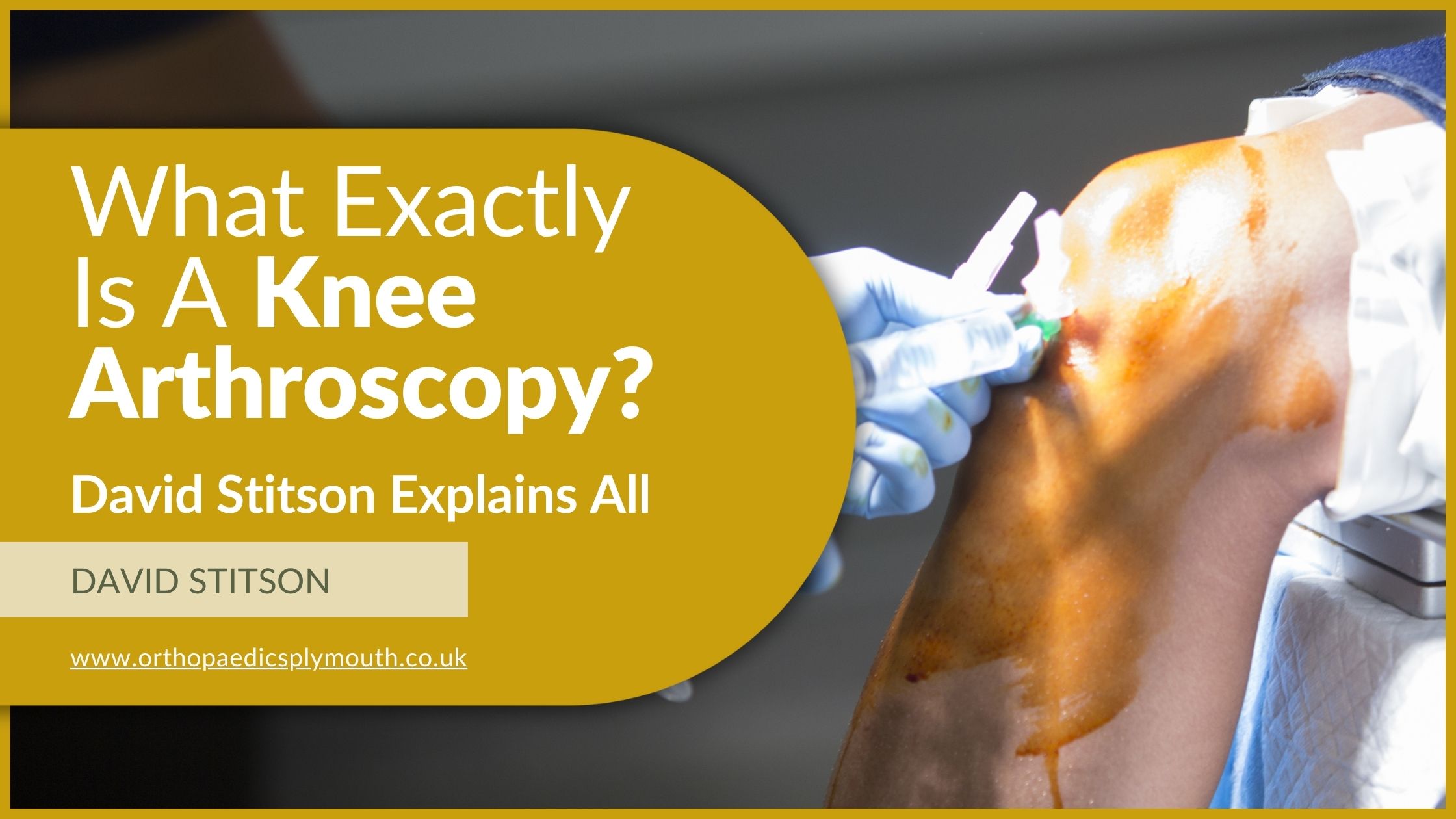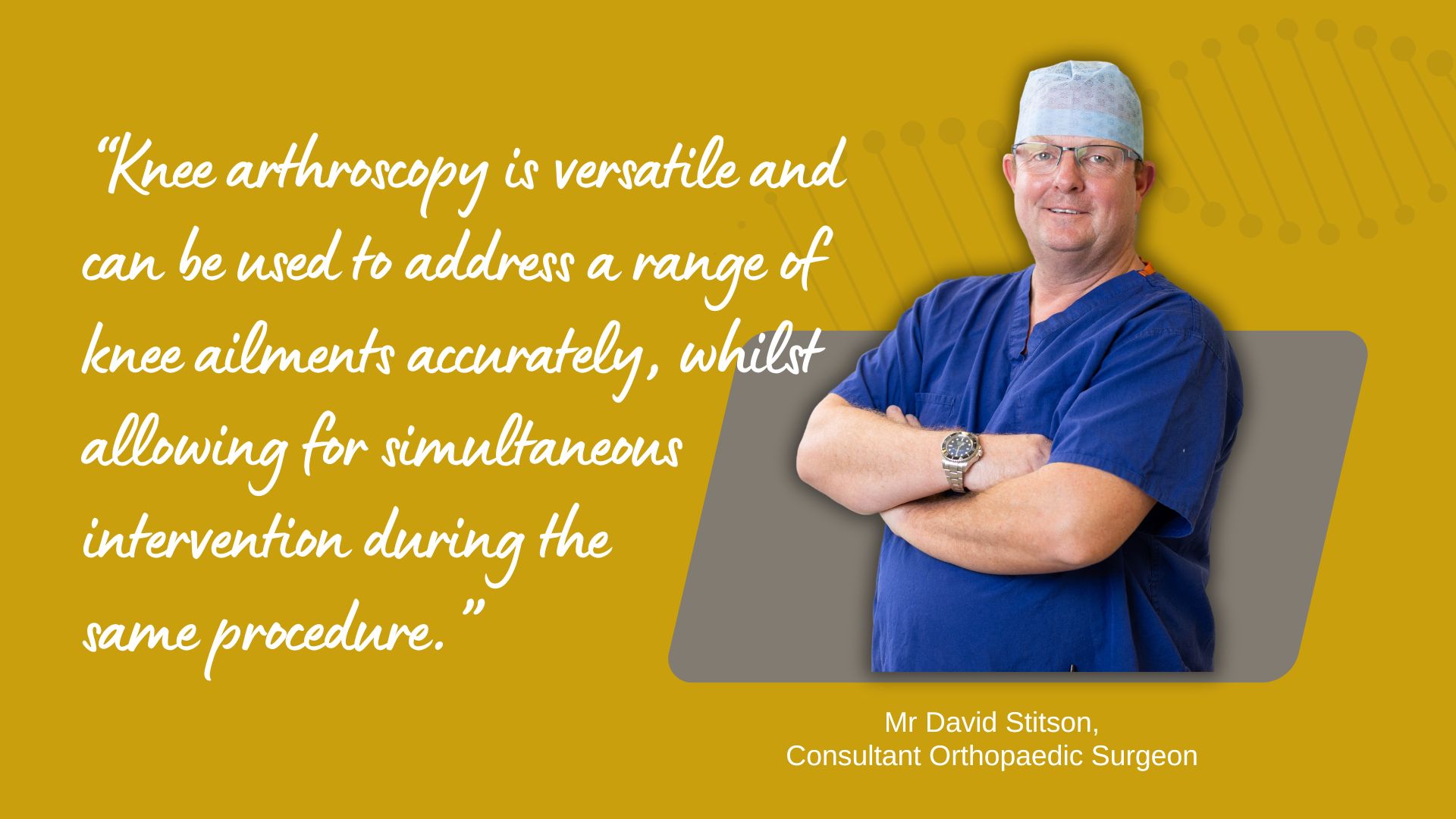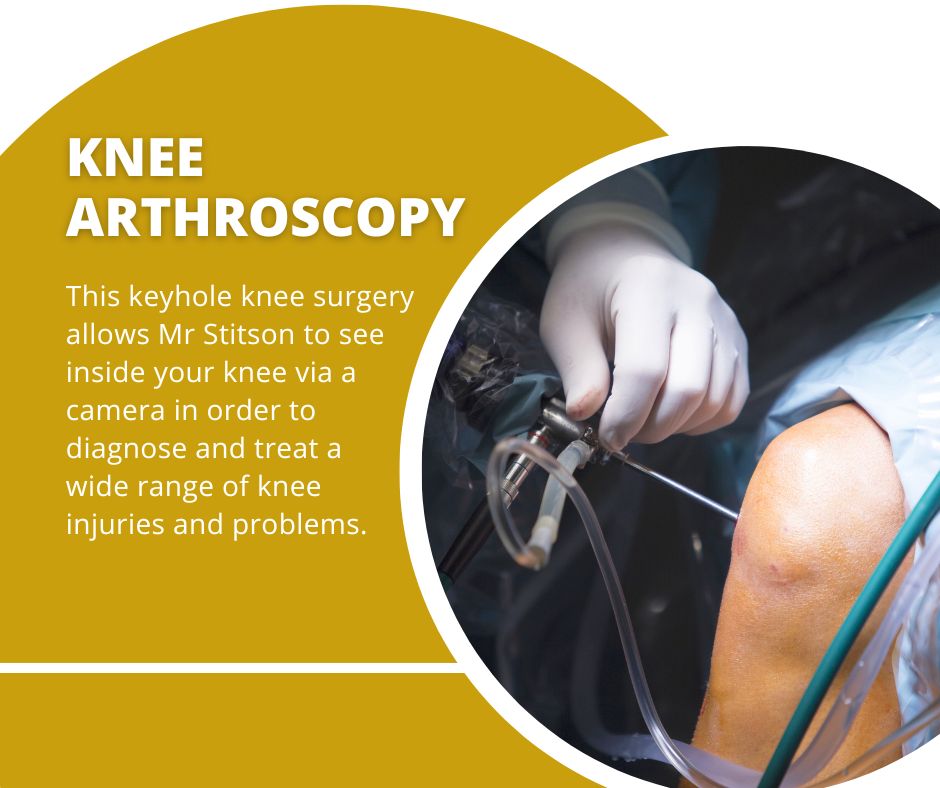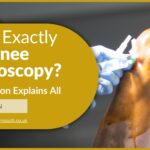Knee arthroscopy is a medical procedure that can significantly improve knee joint health with minimal invasiveness.
This type of knee surgery is can be beneficial both for diagnosing and for treating various joint conditions.
Contents
ToggleUnlike traditional open surgery, knee arthroscopy uses a small camera called an arthroscope, along with specialised instruments, to assess and address problems within the knee.
By employing such advanced techniques, patients can benefit from a quicker recovery time, reduced pain and minimal scarring.
About Knee Arthroscopy
Although knee arthroscopy has been around for many years, the development of the technique represented a significant advancement in the field of orthopaedic surgery, offering a less invasive option for diagnosing and treating various knee joint conditions.
Definition of Knee Arthroscopy
Knee arthroscopy is a minimally invasive surgical procedure employed to examine and treat problems inside the knee joint. A small camera, known as an arthroscope, is inserted into the knee joint through tiny incisions. The arthroscope captures images of the joint’s interior, which are displayed on a monitor, allowing Mr Stitson to see the condition of the knee structures in great detail. This method is not only diagnostic but can also facilitate treating or repairing damaged tissues.
How Knee Arthroscopy Differs from Traditional Surgery
The primary difference between knee arthroscopy and traditional open knee surgery lies in the approach. Traditional surgery typically involves larger incisions and more extensive exposure of the joint, which can result in a longer recovery period and increased risk of complications. In contrast, knee arthroscopy employs very small incisions, which significantly reduces tissue damage and associated trauma to the knee.
Benefits of knee arthroscopy over traditional surgery include:
– Less pain post-surgery
– Reduced risk of infection
– Quicker recovery time
– Minimal scarring
This minimally invasive approach helps patients return to their daily activities sooner and often with fewer complications.
Common Conditions Treated by Knee Arthroscopy
Knee arthroscopy is versatile and can be used to address a range of knee ailments, including:
– Meniscal Tears: The menisci are cartilage pads that cushion and stabilize the joint. Tears can occur due to injury or degeneration.
– Cruciate Ligament (ACL or PCL) Tears: These are common sports injuries affecting the knee’s stability.
– Cartilage Damage: Degeneration or injury to the joint surface cartilage within the knee can lead to pain and restricted movement.
– Synovial Inflammation: Inflammation of the synovial lining can be diagnosed and treated through arthroscopy.
– Loose Bodies: Fragments of bone or cartilage that are floating within the joint space can be removed.
Knee arthroscopy can diagnose these conditions accurately and allow for simultaneous intervention during the same procedure.
The Knee Arthroscopy Procedure
For patients suffering from knee conditions, understanding the entire knee arthroscopy procedure can ease apprehension and prepare them for what lies ahead.
Preparation for Surgery
Preparing for knee arthroscopy is a straightforward process but requires precise adherence to medical advice to ensure optimal results. Here’s what typically happens:
– A set of pre-surgical tests, including blood work and imaging, may be performed.
– Patients will meet with their surgeon to discuss the procedure and clarify any doubts.
– Fasting may be required for a set period before the operation.
– A consent form must be signed, acknowledging understanding of the procedure and its risks.
Patients should also arrange for transport home after the procedure, as they will not be able to drive post-surgery.
The Surgical Process
On the day of the surgery, the patient can expect the following:
– Anaesthesia: Either general or regional anaesthesia is used to numb the pain, depending on the patient’s condition and the surgeon’s preference.
– Incisions: Two or more small incisions are made around the knee.
– Insertion of Arthroscope: The arthroscope is inserted and saline solution is injected to expand the joint, providing clearer images.
– Diagnosis and Treatment: Using visuals on a monitor, Mr Stitson identifies the issue and carries out necessary repairs, such as trimming a torn meniscus or smoothing rough cartilage.
The entire surgical procedure typically lasts about 30 minutes to an hour, depending on the complexity of the issue under treatment.
Postoperative Care and Recovery
After the surgery, immediate care is taken in a recovery room where the patient is monitored as the anaesthesia wears off:
– Pain Management: Pain relief medications are administered as needed.
– Home Instructions: Clear instructions on wound care, medications, and activity restrictions are provided.
– Follow-Up Appointments: These are crucial for monitoring recovery and ensuring proper healing.
Recovery usually involves:
– Physiotherapy: A crucial component to regain strength and flexibility.
– Gradual Weight Bearing: Patients may use crutches initially, progressing to full weight-bearing as advised.
– Resumption of Normal Activity: Light activities can be resumed within a few weeks, while full recovery may take several months.
Ultimately, knee arthroscopy provides a quicker and more efficient route to recovery compared to traditional surgery, enabling those affected to return to their daily activities with greater ease and confidence.
Benefits of Knee Arthroscopy
Knee arthroscopy is a surgical technique that has gained popularity owing to its effectiveness and minimally invasive nature. It is a procedure that allows Mr Stitson to diagnose and treat problems in the knee joint without the need for large incisions.
Here are the various benefits associated with Knee Arthroscopy Surgery.
Minimally Invasive Nature
One of the most significant advantages of knee arthroscopy is its minimally invasive approach. Traditional knee surgeries often require large incisions that increase the risk of infection and prolong recovery time. In contrast, knee arthroscopy involves making very small incisions, typically around a centimetre long, through which a camera and specialised instruments are inserted. This method reduces the trauma to surrounding tissues and leads to fewer complications during and after the surgery.
– Less pain and scarring: As the incisions are smaller, patients experience less postoperative pain and minimal scarring, contributing to better cosmetic outcomes.
– Outpatient procedure: Many patients are able to return home the same day, avoiding the need for an extended hospital stay.
Shortened Recovery Time
The minimally invasive nature of knee arthroscopy means that recovery times are significantly shorter than with traditional knee operations. For many patients, this is a significant factor when considering surgical options, as it means less disruption to daily life.
– Quicker return to activities: Most patients can resume normal activities within a few weeks, and many athletes find they can return to their training routines much sooner than expected.
– Reduced rehabilitation: Although physiotherapy is still necessary to ensure a full recovery, the duration and intensity are often much less demanding compared to traditional open surgery.
Improved Knee Joint Health
Knee arthroscopy not only aids in the diagnosis but also improves the functionality of the knee joint. By allowing Mr Stitson to directly view the inside of the knee, he can address the root causes of knee problems effectively.
– Accurate diagnosis: Mr Stitson can get a close-up view of the interior components of the knee joint and identify issues — whether it’s a torn meniscus, damaged cartilage, or inflamed synovial tissue.
– Enhanced joint function: By rectifying the specific issues affecting the knee, patients often report significant improvements in joint function and a decrease in discomfort or pain.
Risks and Considerations
While knee arthroscopy offers numerous benefits, like all medical procedures, it is not devoid of risks and considerations. Patients considering this surgery should be well-informed about the potential complications and realistic outcomes.
Potential Complications
Although knee arthroscopy is safer and less invasive than traditional open procedures, it does carry some risks.
– Infection: Despite the smaller incisions, there is still a minor risk of infection, which can usually be managed with antibiotics.
– Blood clots: As with any surgery, there is a small risk of developing blood clots. Surgeons generally take precautions to minimise this risk.
– Nerve or tissue damage: There is a very small chance of accidental damage to nerves or tissues during the procedure.
Long-term Outcomes
The long-term outcomes of knee arthroscopy can vary depending on the individual’s condition and lifestyle.
– Durability of repair: While many patients experience lasting relief, some may require further procedures or continuous therapy to maintain joint health.
– Arthritis risk: There may be a continued risk of arthritis developing in the knee joint following the surgery, particularly if significant damage was present beforehand.
When to Consult a Specialist
It is crucial to know when knee problems warrant a specialist’s attention. Consulting an orthopaedic surgeon, such as Mr Stitson, is advisable under specific circumstances.
– Chronic knee pain: If knee pain persists despite non-surgical treatments, it may be a sign that deeper issues are present.
– Mobility limitations: Difficulty with mobility that interferes with daily life may require professional evaluation.
– Recurrent injuries: Individuals with repetitive knee injuries should seek expert advice to prevent further damage and consider the potential benefit of arthroscopic surgery.
Knee arthroscopy is an excellent solution for many suffering from knee joint issues. However, it is vital to weigh the benefits against possible risks and make informed decisions in consultation with your healthcare professional.
Knee Arthroscopy FAQs
Q: What conditions can knee arthroscopy treat?
A: Knee arthroscopy can address a variety of conditions, including:
- Torn meniscus
- Damaged cartilage
- Ligament tears
- Synovial issues
- Fractures within the knee joint
Q: Is knee arthroscopy painful?
A: While you might experience some discomfort during recovery, knee arthroscopy is generally less painful than traditional open surgery. Post-operative pain is typically managed with prescribed medication.
Q: How long does recovery take?
A: Recovery times can vary, but many patients return to normal activities within 6-weeks. Physiotherapy is often recommended to speed up the recovery process and restore knee function.
Q: Are there risks associated with knee arthroscopy?
A: As with any surgical procedure, there are risks, including infection, blood clots or nerve damage. However, these are relatively rare due to the minimally invasive nature of the procedure. It is crucial to discuss potential risks with Mr Stitson prior to surgery.
About Knee Surgery
Knee replacement surgery replaces the worn out, painful and stiff knee joint with a new prosthetic joint. This procedure which may be a partial or a total replacement is normally performed under spinal anaesthesia and is usually followed by a night or two in the hospital. Day-case knee replacement surgery may be an appropriate option for you.

About Mr Stitson
David Stitson is a Plymouth-based Consultant Trauma and Orthopaedic Surgeon.Trained both in the UK and internationally, he has worked in medicine for more than 20 years for the NHS, for the Royal Air Force and in private practice. Mr Stitson operates privately at the Nuffield Health Hospital, Plymouth.








